�
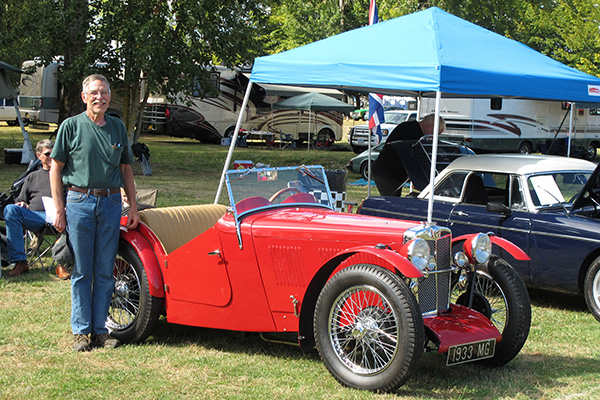
�
Brian Laine's 1933 MG J2 Midget with Ford "60" Flathead V8
� as published in BritishV8 Magazine, Volume XXIII Issue 1, December 2017�� Owner: Brian Laine
� City: Arlington, Washington
� Model: 1933 MG J2 Midget
� Engine: Ford 60 flathead V8
� Built by: owner � �
�
Introduction and Historical Context
��
This website traces its history to "The MG V-8 Newsletter", which was first published in 1993.�
In ensuing years, we've featured over 350 "How It Was Done" articles about installations�
of American V8 engines into classic MG sports cars. This is the oldest car we've featured to date.�
And this car features the earliest V8 engine we've shown too. But it's a newly completed engine�
swap, and we're delighted to show it in great detail because it's an exceptional example.�
�
We anticipate some readers may like a bit of context. So, for starters... the MG marque dates to�
1923. William Morris, proprietor of Morris Motors Limited, conceived MG as a "skunk works"�
to build exciting sports cars and racecars using off-the-shelf and modified parts from�
mass-produced automobiles. By 1932, "The M.G. Car Company, Ltd." was producing sports cars in�
significant numbers at a small factory in Abingdon, in Oxfordshire, in England. (If you're�
curious to dive deeper into MG's early history, we'd recommend starting with this article:�
Abingdon For MG Enthusiasts.)�
�
The name "Midget" historically described many different MG cars before becoming an official model�
designation (in 1961). MG differentiated between early Midgets by assigning alphabetic series�
designations. Between 1932 and 1934, four versions of "J-Type" Midgets were produced. Of J-Types,�
the most numerous is the "J2": 2083 MG J2 Midgets were built. Approximately 450 are thought to survive,�
worldwide. The concurrent J1 model is similar, except with a modest back seat. Just 380 J1's�
were produced. J3 and J4 variants were built specifically for racing. Both of those models feature�
de-stroked and supercharged engines and larger brakes. (22 and 9 were built, respectively.)�
J4's are distinguishable from J3's by their special, lightweight bodies.�
�
Although MG didn't export J-Types to North America, the MMM Register reckons�
at least 76 reached these shores. Famously, some were brought home by American�
airmen at the close of World War II. Though built in the depths of The Great Depression,�
in some ways the J-Type Midgets better represent the roaring twenties. Butterfly hoods,�
cycle fenders, tall narrow tires, cable operated brakes, and friction shock absorbers were�
just some of their anachronistic features. But they differ in a crucial way from American�
automobiles of the 1920s - or any era - they're much lighter! That's what makes them so fun�
to drive.�
�
On the other hand, they weren't powerful by any objective standard. In pre-war England, annual automobile�
taxes were based on piston surface area, and most engines were designed accordingly. The MG engine was closely�
derived from the Wolseley-developed Morris Minor 847cc engine. As in the Minor, a regular J-Type MG engine had�
four tiny little 57mm pistons which traveled 83mm up and then 83mm back down for every rotation of the crank.�
That's a bore-to-stroke ratio of just 0.69:1. Which is terrible. Once you comprehend that, it's easier to understand�
how they only produced 36 horsepower. Now, you might expect J3 and J4 racing engines would have a larger�
bore diameter for more displacement, bigger valves, better porting, etc. Evidently that wasn't feasible.�
So, surprisingly, MG reduced stroke on J3 and J4 racing engines to just 73mm to make them eligible for competition�
in 750cc class racing. (Supercharging and exotic fuel cocktails were also part of the 750cc recipe.) In retrospect,�
choosing to compete in a smaller engine class made sense. Supported by just two main bearings, all J-Type�
crankshafts were fragile, and a shorter stroke would help avoid failures. Top ends were more of a mixed bag.�
On one hand, an overhead cam driven via bevel gears provided admirably precise valve timing. Devotees report that�
cam timing is reliably accurate to less than 1/2 degree of crankshaft revolution, even at speeds as�
high as 5500rpm. On the other hand, setting these engines' rocker arm geometry is notoriously difficult�
and time consuming. Also, seal failures between camshafts and cam-driven generators resulted in oil�
leaks and subsequent engine fires. Bottom line: many J-Types have benefitted from engine swaps.�
�
We don't know what failure destroyed this particular J-Type's original MG engine, but it's had two very�
different engine swaps. A previous owner installed a British Ford "Prefect" side-valve, four-cylinder engine. �
"Where", "when", and "by whom" are unknown. We're left to wonder: What American would choose a Prefect engine?�
Indeed, where would they even find one? Yet somehow this J2 made its way to Washington state and then sat�
derelict with a Prefect engine between its frame rails from about 1972 onward until Brian found and�
purchased it.�
�
Without the original MG engine to work with, Brian considered alternatives and the Ford "V8-60" model engine�
easily won out. They're almost contemporary to the J2 and many thousands were manufactured. In North America,�
Ford produced V8-60 engines from 1937 through 1940, but after WWII V8-60 production continued in other parts of the�
world. (In particular, Simca produced V8-60 engines under license until 1960.) These little engines are compact,�
relatively easy to source, affordable, and are still well supported with aftermarket hop-up and dress-up parts. �
�
It's difficult to say who built the very first V8-60 powered MG sportscar, but it's pretty easy to�
associate some famous people to this combination.�
�
In 1950, Bill Stroppe¹ built an MG TC V8-60 racecar for William Cramer of Los Angeles. Although Cramer�
sometimes drove, more often than not he shared his MG-V8 with Cal Club friends including Arnold Stubbs,�
Phil Hill², and Richie Ginther³. Humorously, Cramer's MG-V8 usually wore racing number "2Jr"�
whilst Phil Hill's Jaguar XK120 was entered as racecar "2". When Phil Hill won the 1950 Pebble Beach Cup,�
de facto teammate Arnold Stubbs was chasing him valiantly in 2Jr. Phil Hill got his own chances to drive�
2Jr at Carrell Speedway on February 25, 1951 (where he finished 4th), at Torrey Pines in September, and at�
Stockton in August of the following year. Phil Hill's close friend and sometimes riding mechanic, young�
Richie Ginther tried out 2Jr at Pebble Beach on May 27, 1951. Ginther placed 3rd overall in a preliminary�
sprint race, but failed to finish the Pebble Beach Cup main event.�
(Incidentally, another MG TC V8-60 was entered in the 1951 Pebble Beach races by one Dick Jones.)�
�
Famous hot-rod builder Doane Spencer of So-Cal Speed Shop fame built an MG TC V8-60 racecar for Paul W.�
Trousdale, who recruited driver Paul Pedigro to pilot it at many race meetings starting from the March 23,�
1952 event at Palm Springs. �
�
At approximately the same time, T. Noah "Tiny" Smith of Smith Import Motors in San Antonio installed a�
V8-60 in his daughter Sugar's MG. Sugar's MG impressed customers and led to more orders: an untold number�
of conversions and possibly some engine swap kits too.�
BritishV8 readers may recall Tiny Smith's more famous venture: his "Jiggler" cylinder head conversion�
kits added overhead exhaust to flathead racing engines as described and photographed in our extensive�
Speedway�
Motors Museum Tour article. �
Specific details of Smith's MG V8-60 conversions are somewhat hard to confirm, but we can�
easily document a bit of their racing success. At the "Guardsman's Trophy Races" at Eagle Mountain�
National Guard Base near Fort Worth in August 1954, Stuart Harvey drove a Tiny Smith owned MG TC V8-60�
racecar to SCCA D-Modified class victory in the Blue Bonnet Cup race. (Some guy named Carroll Shelby�
finished first place overall in that same race, driving a borrowed A-Modified class�
Jaguar C-Type.) As reported by Road and Track magazine, 9000 spectators were looking on. �
�
Brian Laine's MG V8-60 may turn out to be the last built of its breed. If so, at least it's a fantastic�
example. Below, we show "how it was done".�
�
How It Was Done
�| Engine: | �Ford V8-60 engine (136cid, 2.2L).�
Offenhauser aluminum cylinder heads.�
Edelbrock intake manifold.�
Dual Stromberg 81 (0.81" venturi) carburetors.�
Holley fuel pressure regulator.�
Offenhauser block mount water manifolds.�
| �
| Cooling: | �custom radiator.�
9" electric fan. | �
| Transmission: | �Borg Warner T5 5-speed manual, from a Mustang 5.0.�
0.68:1 fifth gear.�
1980 Mustang V6 clutch.�
Wilwood clutch master cylinder.�
Tilton HTOB slave cylinder.�
Flathead Jack bellhousing.�
Custom fabricated prop shaft. | �
| Rear Axle: | �stock MG 5.37:1 rear axle. | �
| Front Susp.: | �Andre Hartford Silentbloc friction shock absorbers.�
1989 Subaru Justy steering rack, narrowed about 7". | �
| Rear Susp.: | �essentially stock. | �
| Brakes: | �converted to hydraulic (including Wilwood master cylinder.) | �
| Wheels/Tires: | �MSW chrome plated 19" 48-spoke wheels.�
Orson Products knock-offs.�
Lucas tires (4.75/5.00 x 19"). | �
| Instruments: | �(right to left)�
original optional-equipment Jaeger "8 day" clock,�
Jaeger mechanical tachometer (0-6000rpm with road speed ranges indicated too),�
Jaeger oil temperature gauge (30-100C).�
Jaeger water temperature gauges (30-100C),�
Jaeger oil pressure gauge (0-160psi), and�
Joseph Lucas Ltd. ampere gauge (-20 to 20 amps). | �
| Electrical: | �Odyssey 400cca absorbed glass mat battery.�
Nippondenso alternator (from a Chevy Metro), with custom machined billet aluminum pulley. �
Automotive Electric brand gear reduction starter. | �
| Interior: | �engine turned aluminum dashboard.�
Home-made mahogany steering wheel.�
Wilwood pedal set.�
Custom throttle pedal and mechanical linkage.�
Custom fabricated fiberglass transmission/driveshaft tunnel. | �
| Body: | �custom fabricated fiberglass front fenders, styled to match original design. | �
| Paint: | �PPG DCC single-stage epoxy paint, in Carmine Red.�
Epoxy primer.�
Sprayable seam-sealer. | �
Engine Installation
� ��
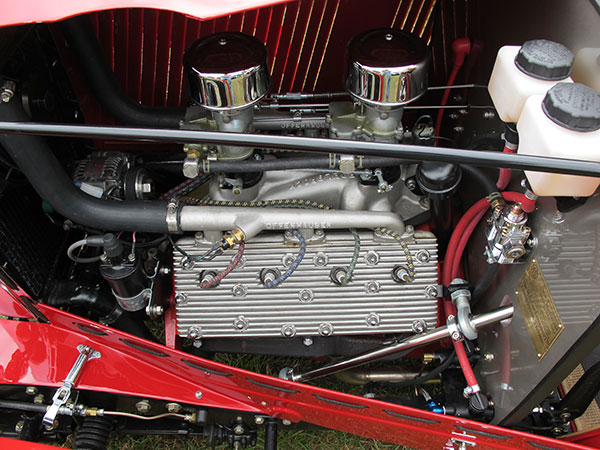
�
Ford V8-60 engine (136cid, 2.2L). Offenhauser aluminum cylinder heads.
�
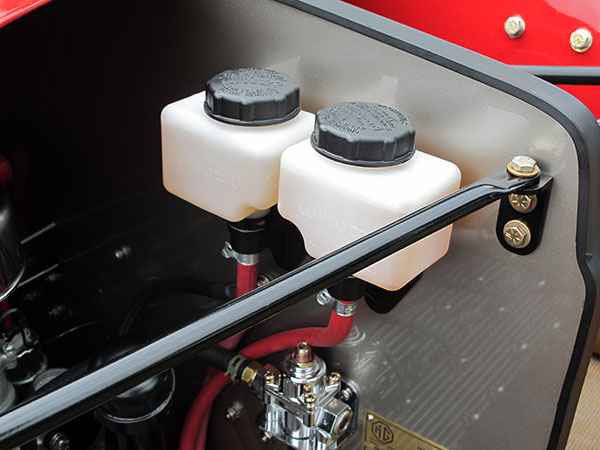
�
Wilwood remote reservoirs for brake and clutch master cylinders.
�
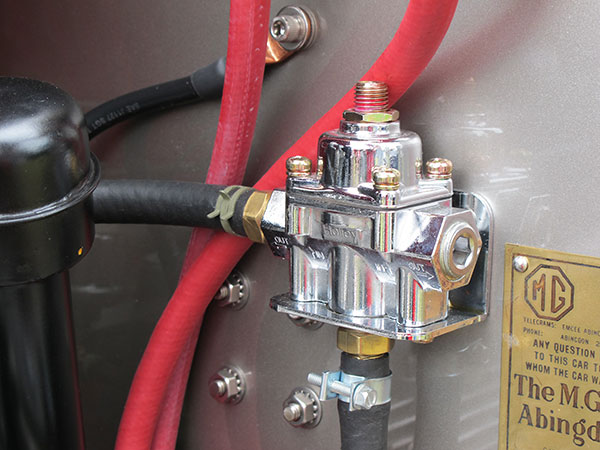
�
Holley fuel pressure regulator.
�
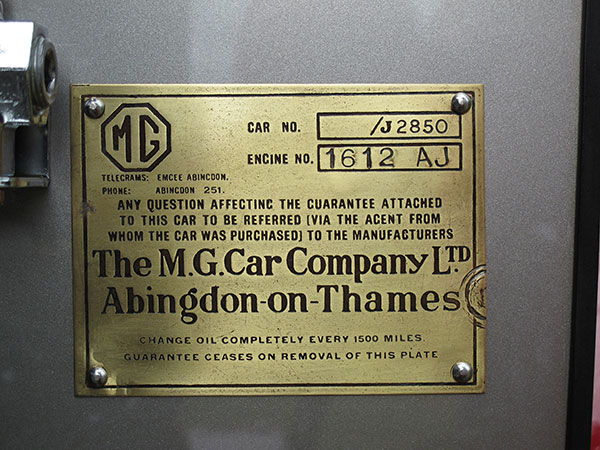
�
The M.G. Car Company Ltd., Abingdon on Thames
�
Telegrams: EMGEE. Phone: Abingdon 251. Car No. /J2850, Engine No. 1612 AJ
�
Any question affecting the guarantee attached to this car to be referred
�
(via the agent from whom the car was purchased) to the manufacturers.
�
Change oil completely every 1500 miles. Guarantee ceases upon removal of this plate.
�
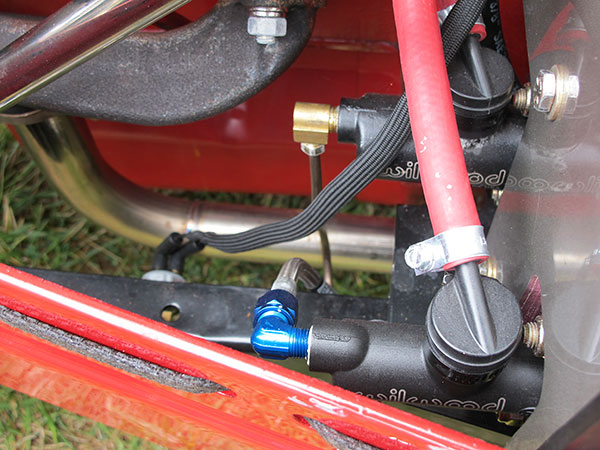
�
Wilwood brake and clutch master cylinders.
�
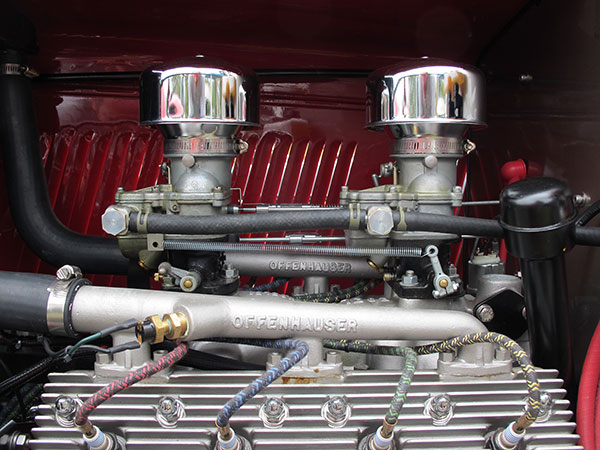
�
Dual Stromberg 81 (0.81" venturi) carburetors.
�
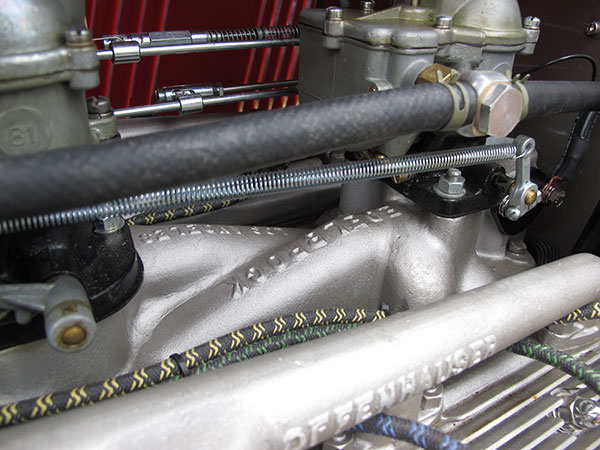
�
Edelbrock intake manifold.
�
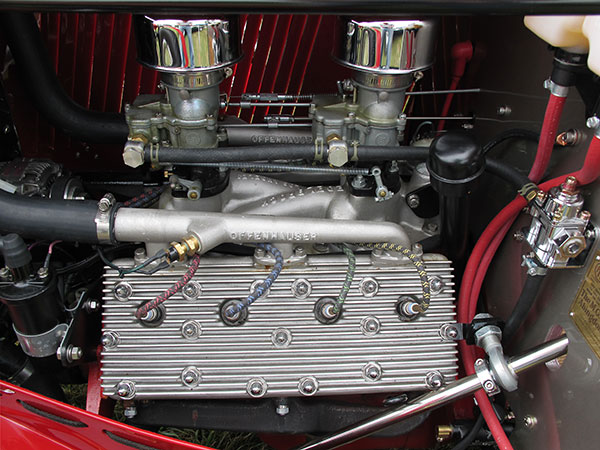
�
Offenhauser block mount water manifolds.
�
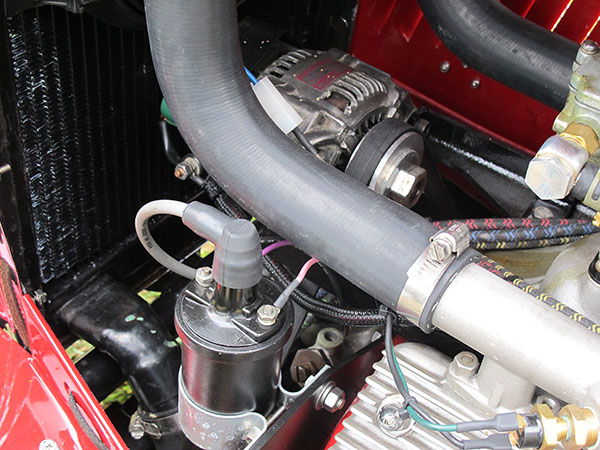
�
Nippondenso alternator, sourced from a Chevy Metro.
�
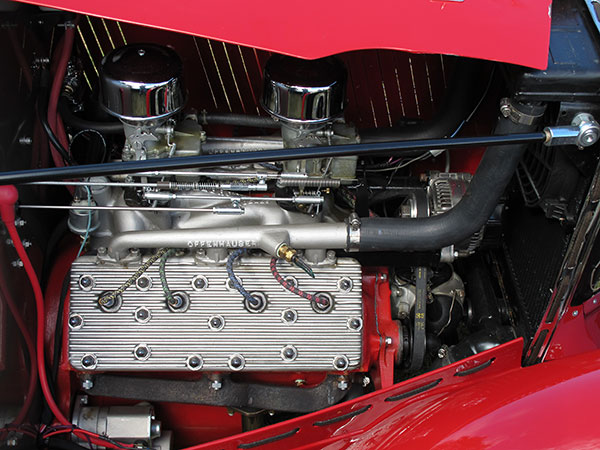
�
2.6" bore by 3.2" stroke, for a 0.81:1 bore-to-stroke ratio.
�
6.6:1 compression ratio. Originally rated 60 hp and 94 lbft.
�
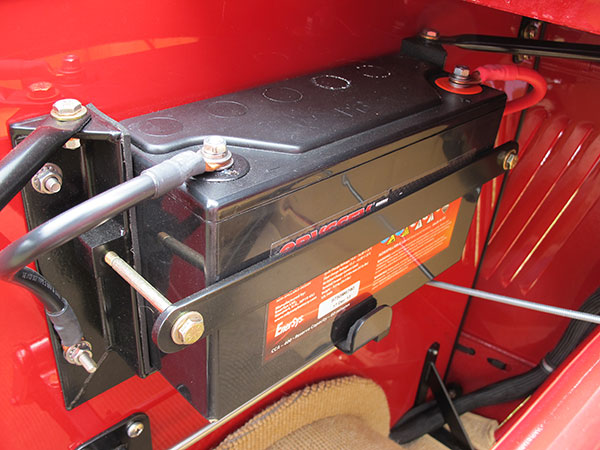
�
Odyssey 400cca absorbed glass mat battery.
�
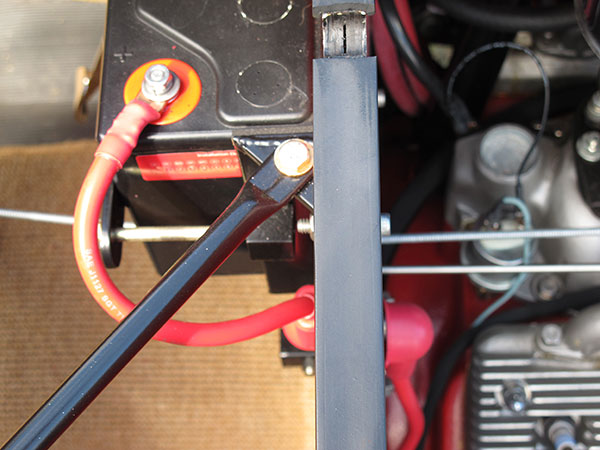
�
Nice, modern battery cable with continuously molded-on PVC insulation. Back in the
�
day, copper battery cable was wrapped in cloth and then fed through a rubber hose.
�
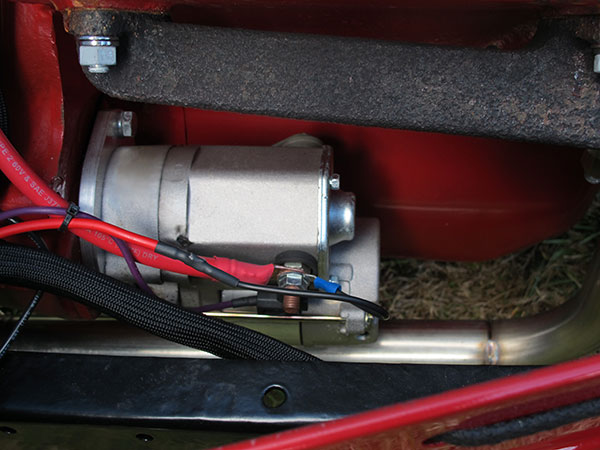
�
Automotive Electric brand gear reduction starter.
�
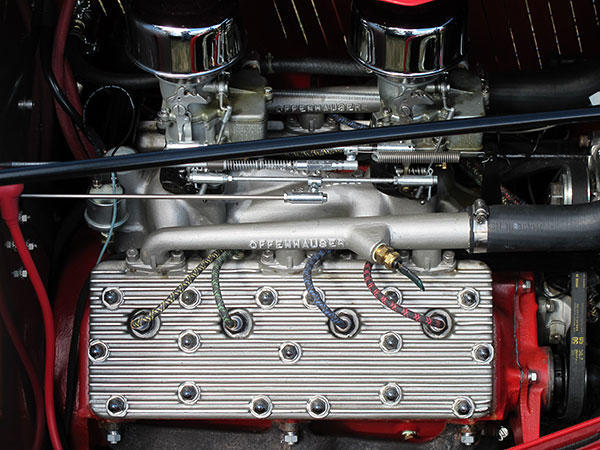
�
Color coded spark plug wires.
�
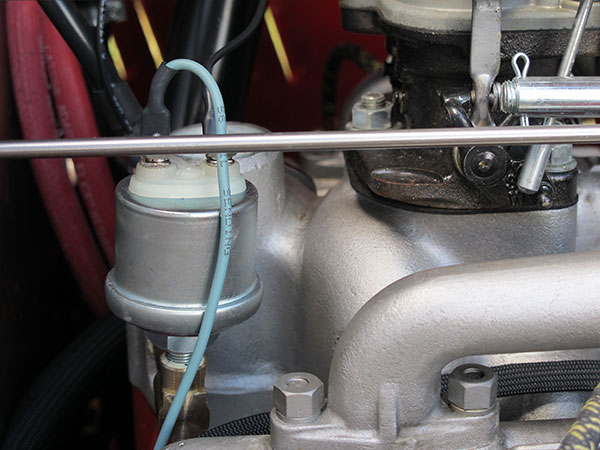
�
Oil-pressure sending unit.
�
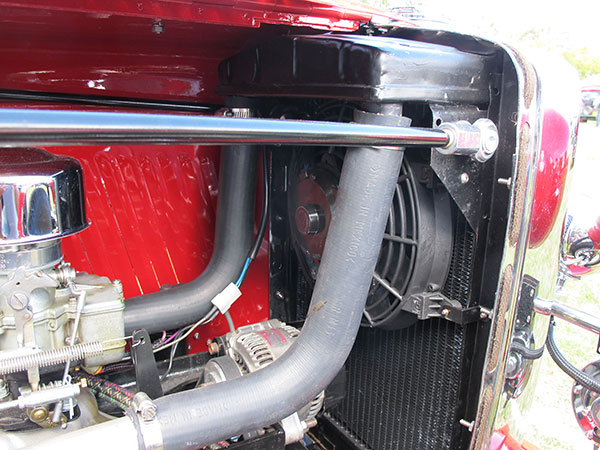
�
Nine inch electric fan.
�
�
Custom machined billet aluminum alternator pulley.
�
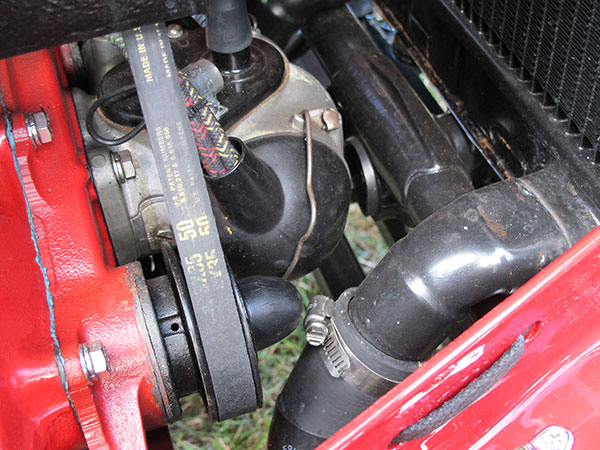
�
Passenger-side Ford 60 water pump. All of Ford's flathead V8 and V6 engines feature dual water
�
pumps, symmetrically located. Very often the iron pump housings also serve as motor mounts.
�
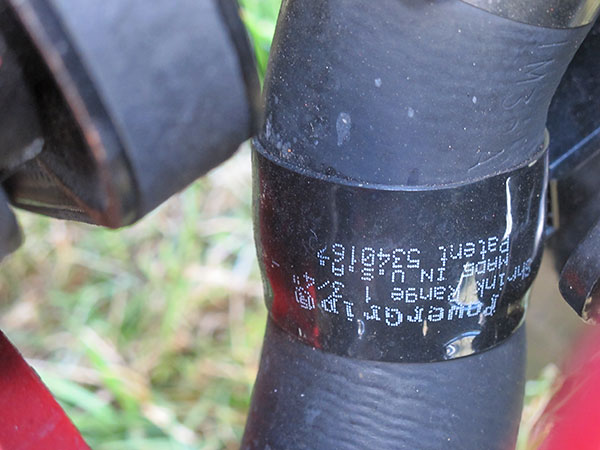
�
Brian enthusiastically recommends Gates PowerGrip heat shrink hose clamps.
�
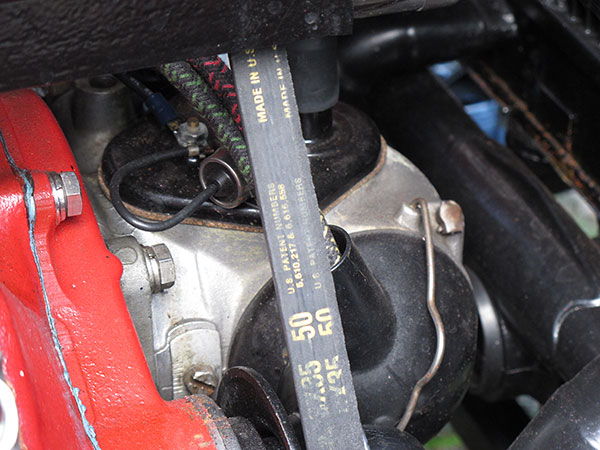
�
Condenser, mounted outside the distributor.
�
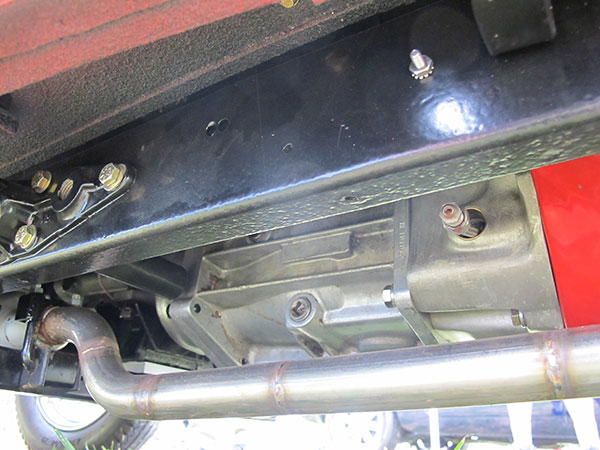
�
Borg Warner T5 5-speed manual transmission. Flathead Jack bellhousing.
�
Front Suspension
��
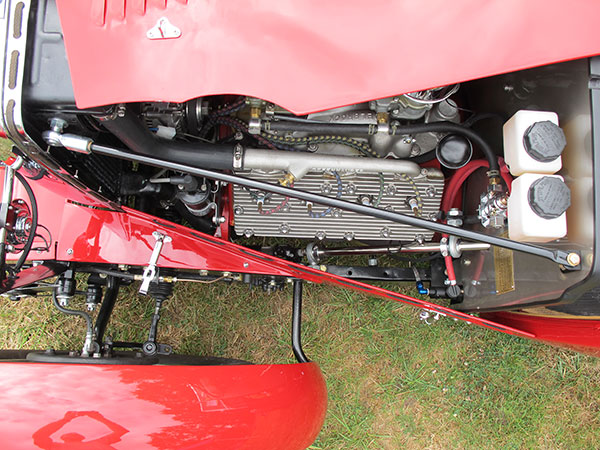
�
Beam axle front suspension.
�
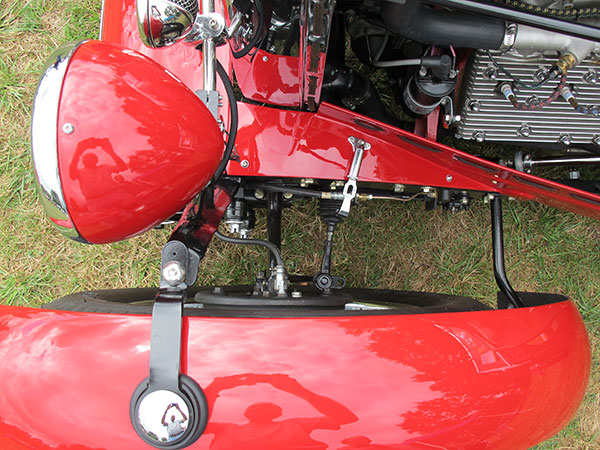
�
J-Types were originally built with cable operated brakes, but most J-Types were converted
�
to hydraulic brakes - typically from later MG models - if they survived past World War II.
�
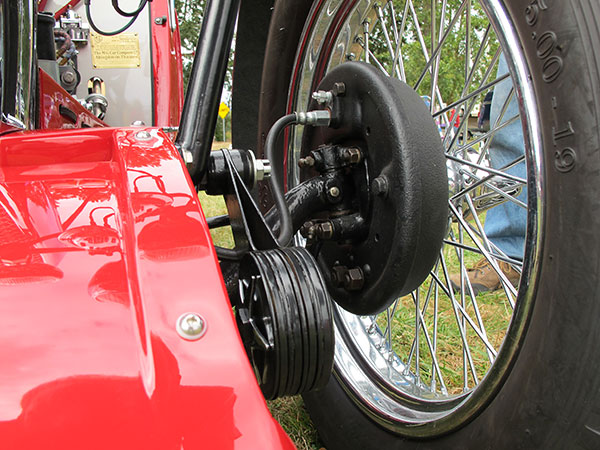
�
J-Types brake drums were just 8" in diameter. For camparison, P-types came with 12" drums.
�
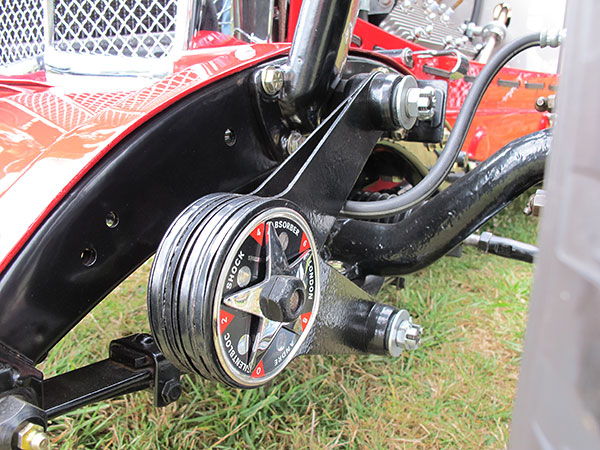
�
Andre Hartford Silentbloc friction shock absorbers.
�
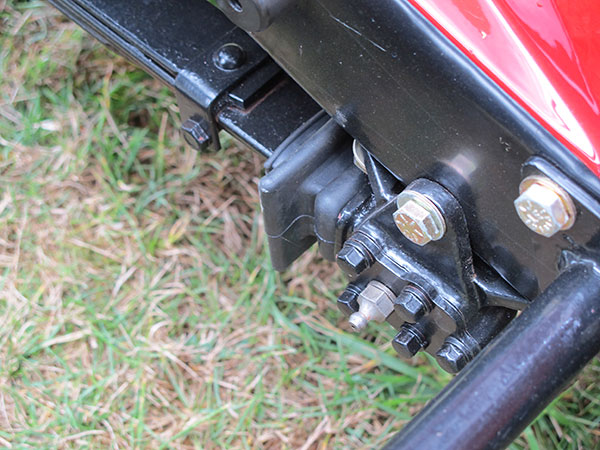
�
At 1427 pounds, J-types were about 225 pounds lighter than P-types.
�
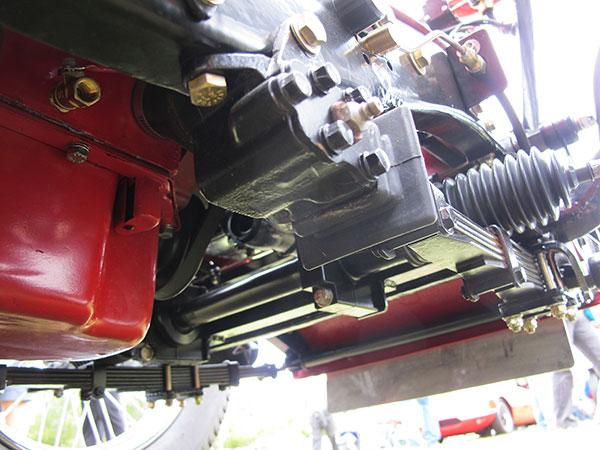
�
1989 Subaru Justy steering rack, narrowed about 7 inches.
�
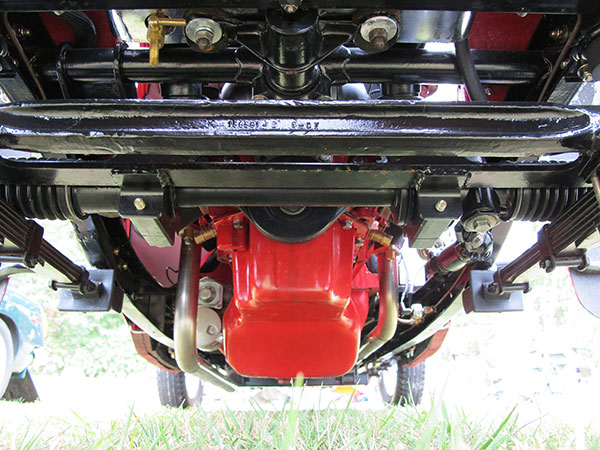
�
The MG's steering rack is mounted to its front axle. There's zero bump steer, but about
�
an eighth inch of displacement (plus and minus) must be made up in the steering shaft.
�
Rear Suspension
� �
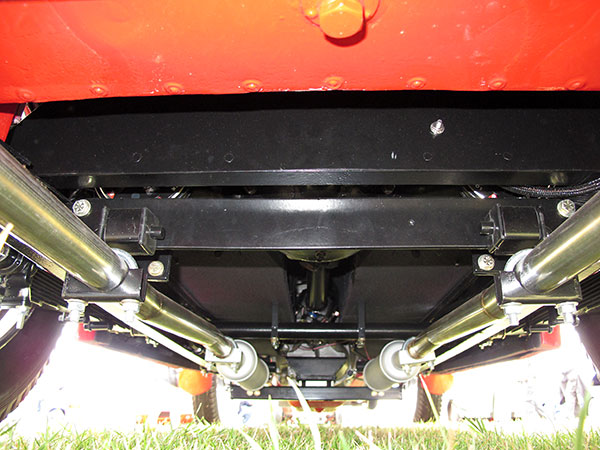
�
Compared to the P-type which followed, J-types have a slightly shorter wheelbase (86" vs. 87 5/16".)
�
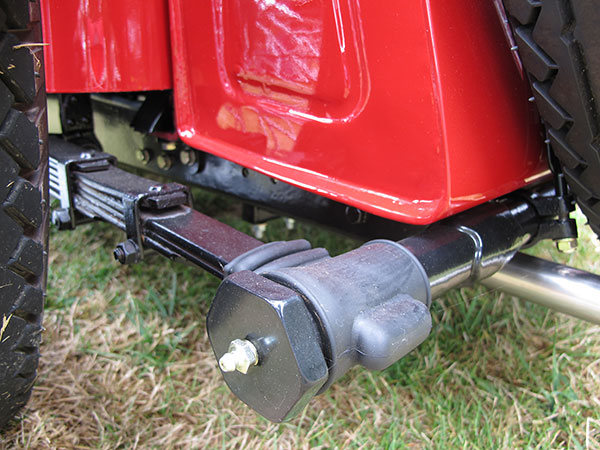
�
Between these two generations of MG sportscars, track width remained unchanged at just 42 inches.
�
Interior
� � ��
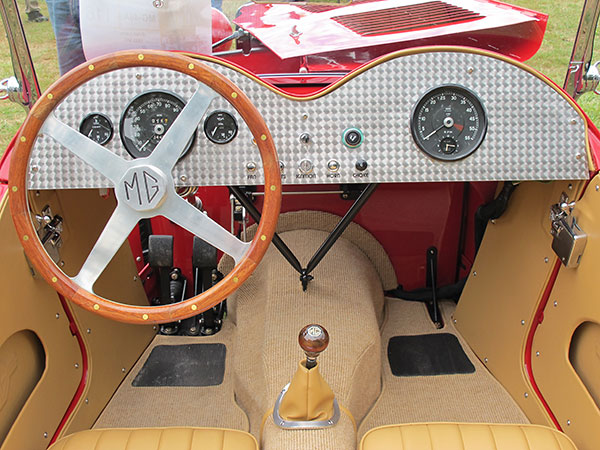
�
Home made 3/16"-thick aluminum dashboard.
�
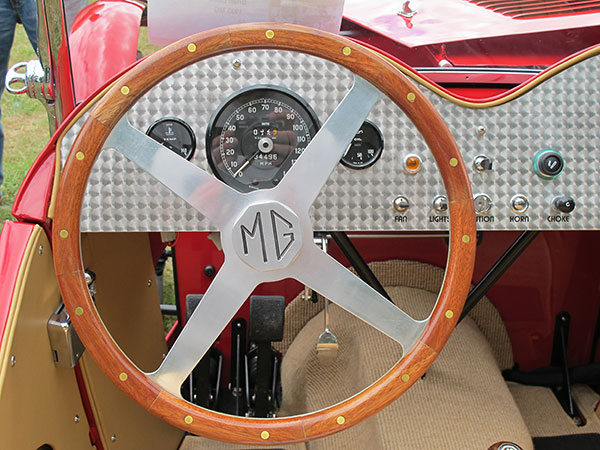
�
Smiths gauges, including a Jaguar XKE speedometer (and tachometer).
�
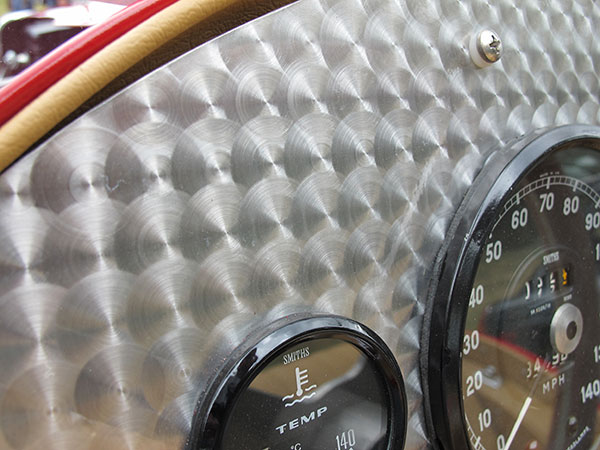
�
Classic decoration: Brian meticulously "engine turned" the dashboard surface.
�
(There are about 1500 centers, with 1/2" horizontal and vertical spacings!)
�
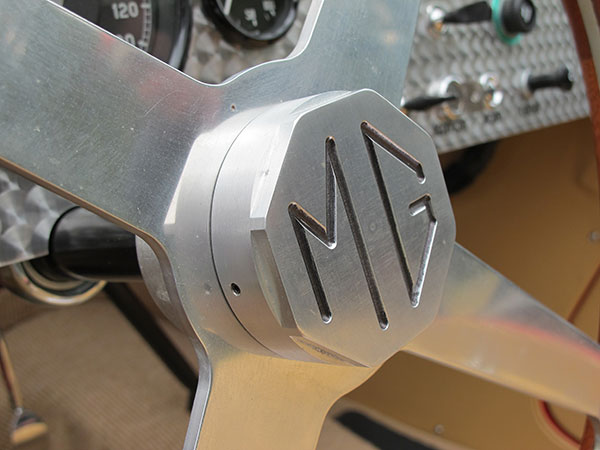
�
Steering wheel hub.
�
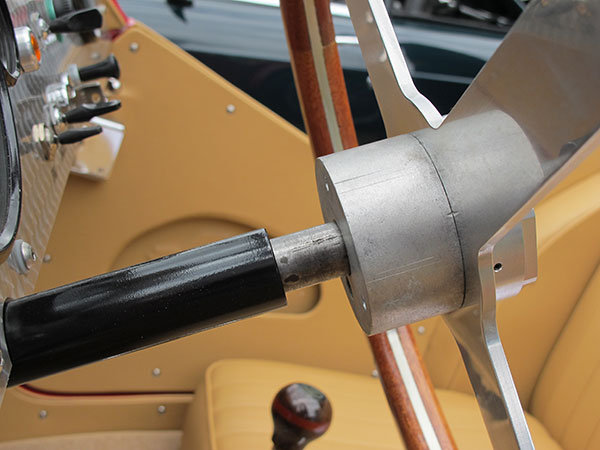
�
(Extended.) Brian's steering column telescopes for driver comfort.
�
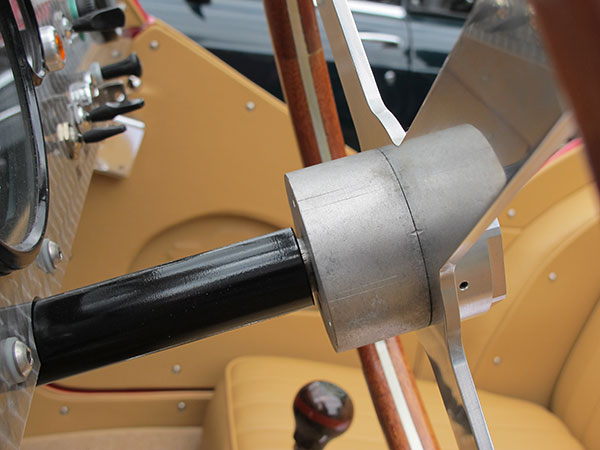
�
(Compressed.) Brian's steering column telescopes for driver comfort.
�
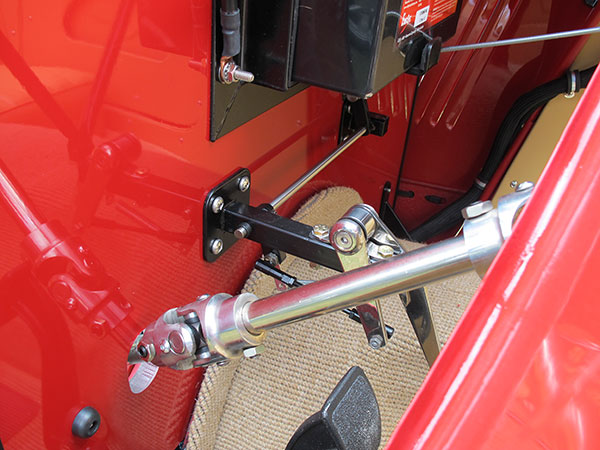
�
Steering intermediate shaft.
�
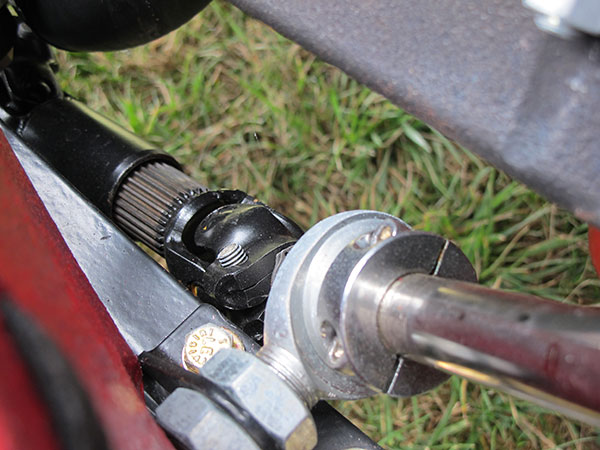
�
A driveshaft-type slip joint, installed in the steering linkage.
�
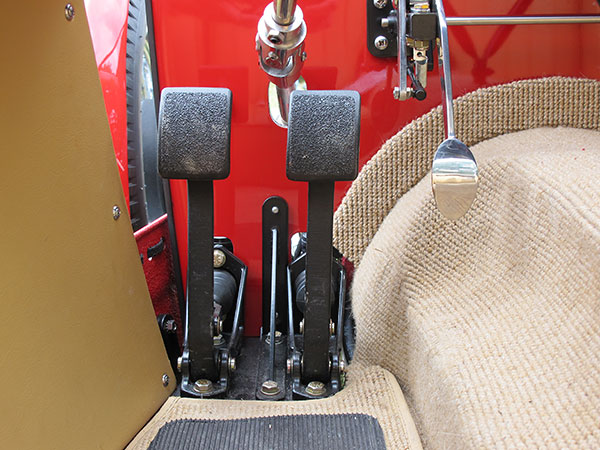
�
Throttle pedal and linkage.
�
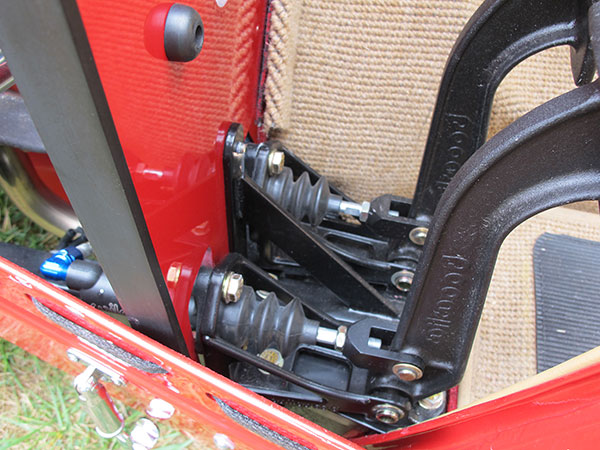
�
Wilwood brake and clutch pedal set.
�
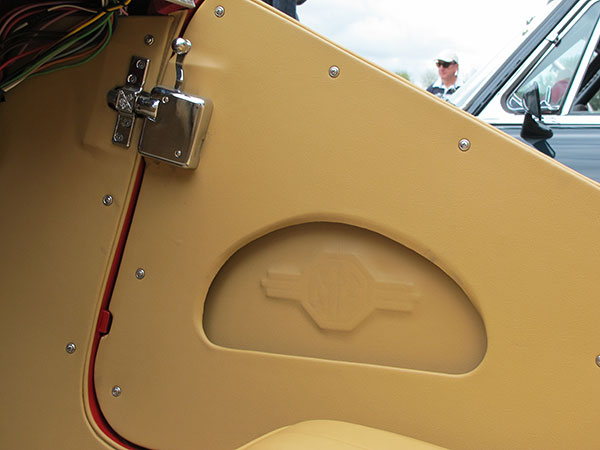
�
Door storage pockets.
�
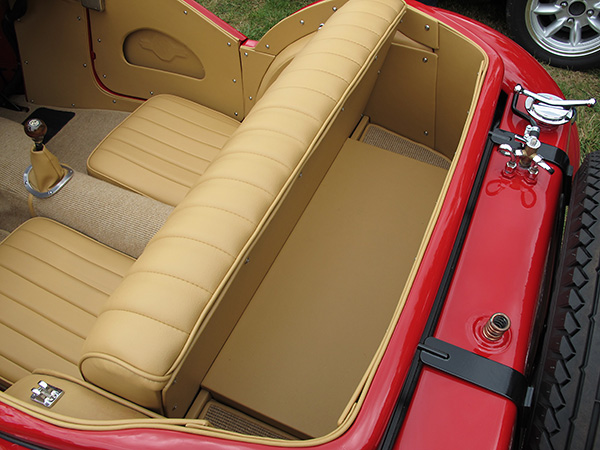
�
Brian's brother Mark did the custom upholstery work - and most of the bodywork too!
�
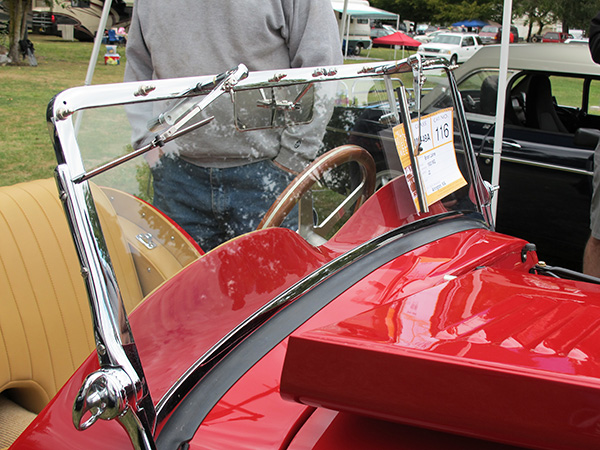
�
Ted's Upholstery recovered the seats and made custom carpets.
�
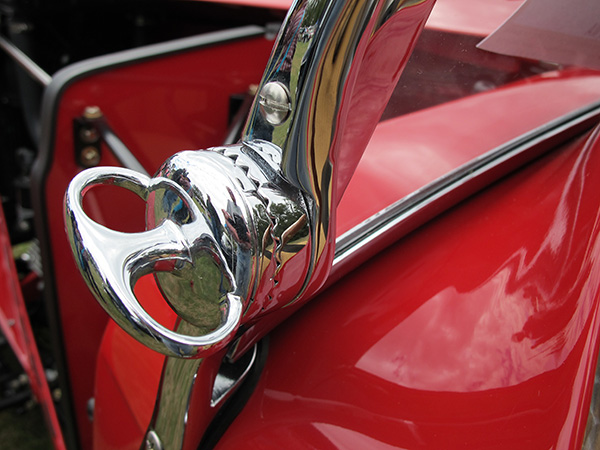
�
Locking hinge mechanism for the fold-down windshield.
�
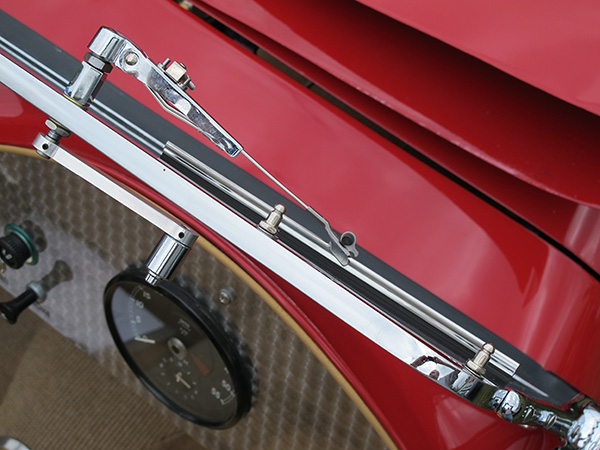
�
Manually operated windshield wipers.
�
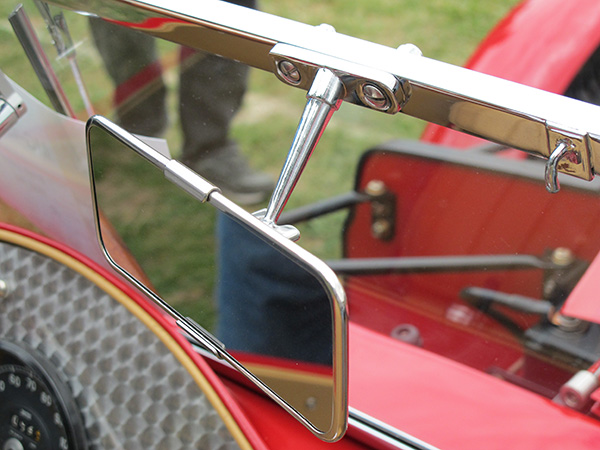
�
Rear view mirror.
�
| �
Enjoying this article? Our magazine is funded through the generous support of readers like you! � To contribute to our operating budget, please click here and follow the instructions. � (Suggested contribution is twenty bucks per year. Feel free to give more!)� |
Exterior
� ��
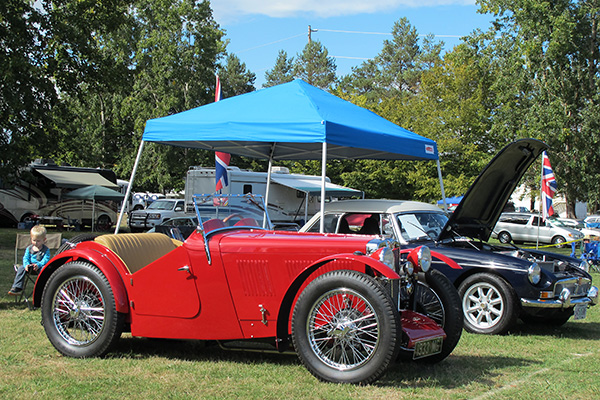
�
Brian's J2 is one of just six cars the MG factory completed on February 7, 1933.
�
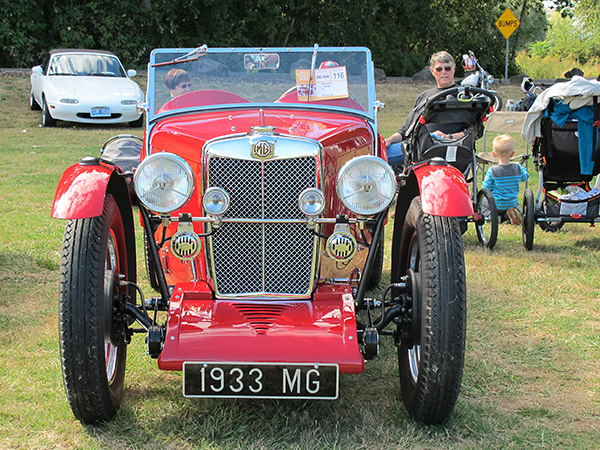
�
Original J-Types had single filament headlamps. The concept of a low-beam/high-beam selector switch
�
didn't apply to them, but "The headlamps are provided with a patented universally adjustable mounting
�
which allows the beam of light to be set to the best advantage. This adjustment is abtained by slacking
�
the hexagon nut, turning the lamp to the desired position and then locking it by tightening up the nut.
�
The near-side headlamp is set to throw its beam to the near side of the road and the off-side (set
�
straight) can be turned off or on independently." (from Blower's MG J-Type Midget Shop Manual)
�
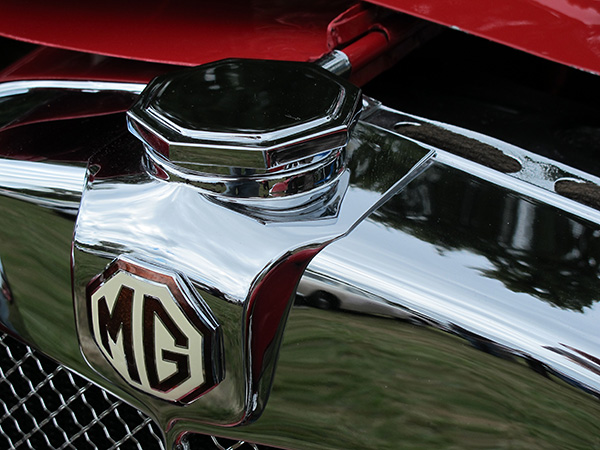
�
Radiator cap.
�
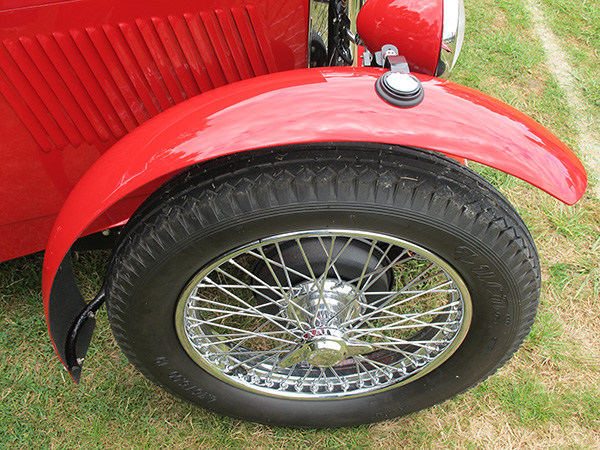
�
MG changed the styling of J2 front fenders during production. Brian fabricated fenders more
�
similar to the earlier cycle fender type, versus the later swept-wing fender type.
�
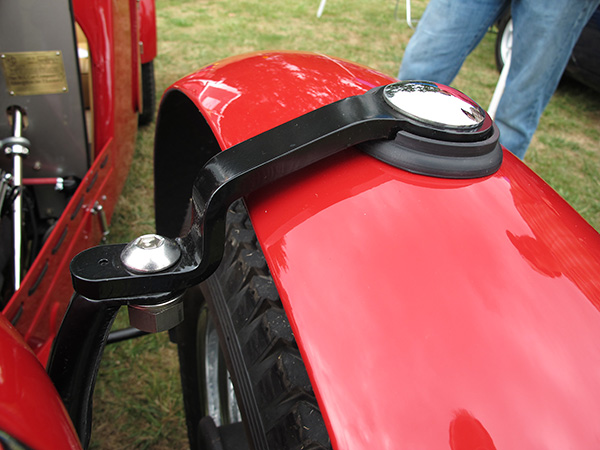
�
However, Brian's front fenders don't turn with the wheels as they're steered.
�
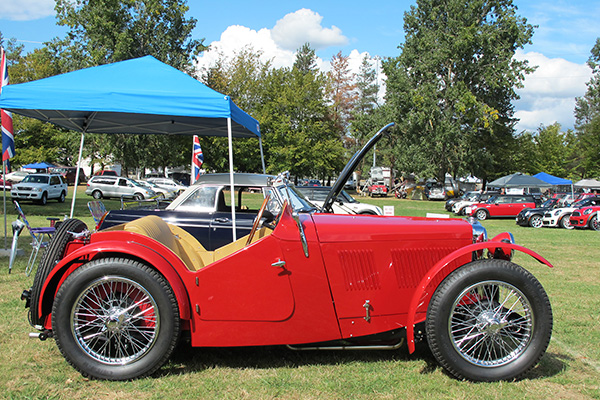
�
Resplendent, in Carmine Red PPG "DCC" single-stage epoxy paint (over epoxy primer)
�
as was applied by W.B.L. Automotive.
�
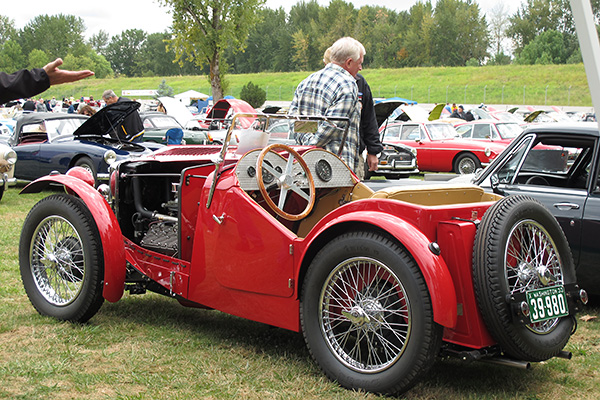
�
Brian Laine's J2 on display at Portland Oregon's 2016 All British Field Meet
�
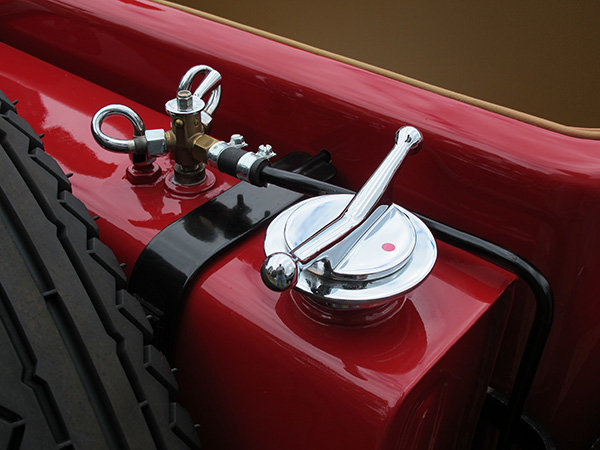
�
Fuel filler cap and vent.
�
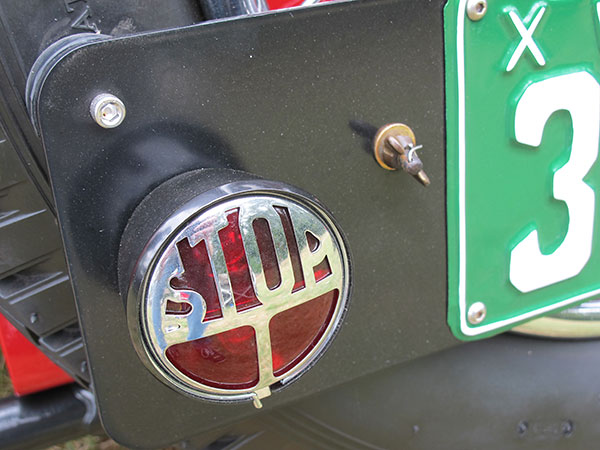
�
Dual "STOP" lamps are a big upgrade.
�
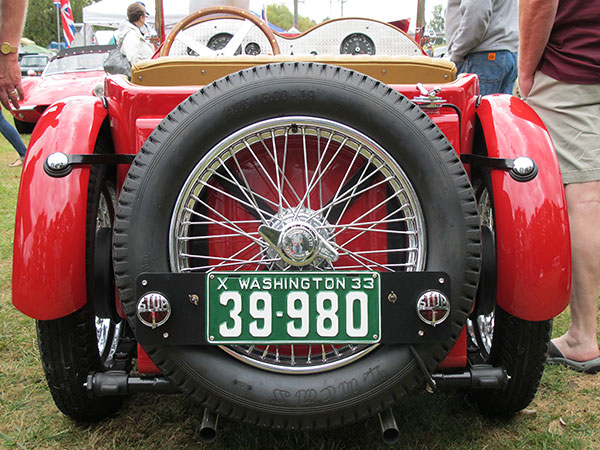
�
Original J-Types have one red tail lamp and no brake lights, although brake lights were
�
invented back around 1905 and were well known on other marques by 1933. According to
�
one source, 11 U.S. states legally required brake lights on cars in 1928. Buick pioneered
�
installation of turn signals in 1939. Other makes didn't follow suit until after WWII.
�
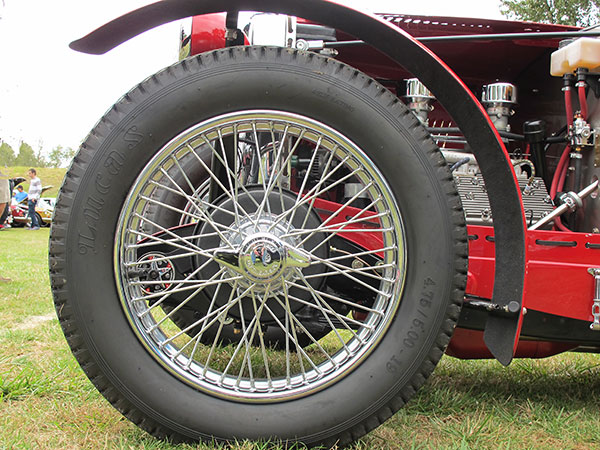
�
MSW chrome plated 19" 48-spoke wheels. Orson Products knock-offs.
�
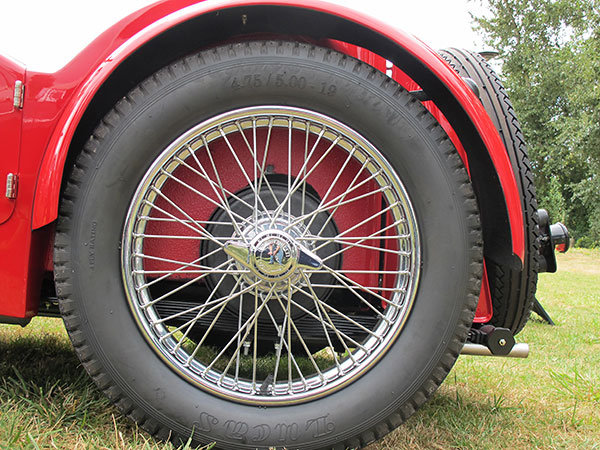
�
Lucas tires (4.75/5.00 x 19").
�
| Notes: | ||
| (1) | �
Bill Stroppe is remembered for managing the team of Lincolns that finished 1-2-3-4 in the�
Touring class of the 1952 and 1953 runnings of La Carrera Panamericana, for riding shotgun�
with racing partner Parnelli Jones in Baja races, and for campaigning Ford Broncos in stadium�
and SuperTruck racing. �
� | |
| (2) | �
Phil Hill is the only American-born driver to ever win a Formula One championship�
(with Ferrari in 1961). Phil Hill also won the 24 Hours of Le Mans and the�
12 Hours of Sebring, three times each. MG fans will recall the world speed records�
Hill set at Bonneville in EX181, a.k.a. "The Roaring Raindrop". �
� | |
| (3) | �
Ultimately Richie Ginther enjoyed a long and successful racing career of his own.�
He's the driver who gave Honda their first Formula One victory. �
� | |
�
Photos by Curtis Jacobson for BritishV8.org.�
Copyright 2017. All rights reserved.�
Use by written permission only.�
(Do not print, copy to your hard drive, or post these online without permission.)
�

